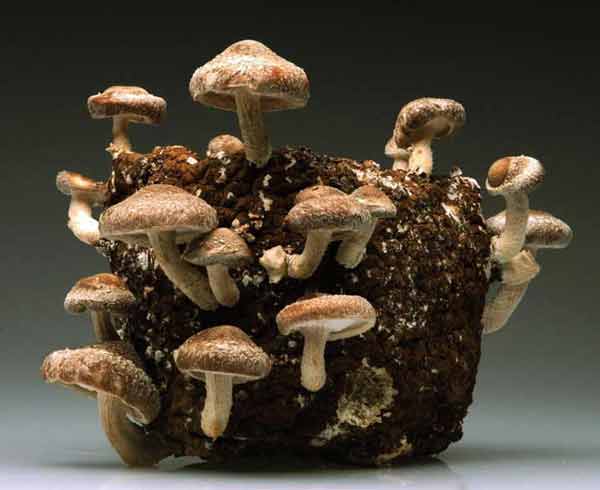Shiitake Mushrooms
Shiitake mushrooms (Lentinula edodes) have a rich, earthy flavor and a distinctive taste best described as meaty. These mushrooms vary in colour from light to dark brown with pale cream undersides and have large caps measuring 2-5 inches wide.

Shiitake mushrooms
Shiitake mushrooms are native to regions of Japan, Korea, and China, where it grows naturally on fallen logs. This species has been used for many centuries for both food and traditional medicine across East Asia. These sought-after mushrooms are now widely cultivated worldwide and account for around 25% of annual production of mushrooms and are the third-most popular mushroom in the world, after oysters and white buttons. Commercially, shiitake mushrooms are typically grown on either artificial substrate or hardwood logs, such as oak.
In Japan, Shiitake can be served in miso soup, used as the basis for many vegetarian dishes and as an ingredient in many steamed and simmered dishes. Modern cookbooks include many recipes using Shiitake.
Health Benefits
Shiitake mushrooms have high levels of natural copper, a mineral that supports healthy blood vessels, bones, and immune support. A half cup of shiitake mushrooms provides around 70% of your daily recommended intake. They are also a rich source of selenium, providing 33 percent of your DRI and contain eritadenine, a compound known to reduce cholesterol levels in the blood, and beta-glucans that reduce inflammation and help prevent the intestines from absorbing cholesterol.
Shiitake are rich in polysaccharides like lentinans and other beta-glucans. These compounds protect against cell damage, help your immune system, and boost white blood cell production for fighting off microbes. Polysaccharides also have anti-inflammatory properties. They are also low in calories and offer good amounts of fiber, as well as B vitamins and minerals.
Growing Shiitake Mushrooms
Beginners will have a little more trouble growing Shiitake than growing mushrooms of other types because their mycelium is not very aggressive, meaning they need longer inncubation times.
Shiitake require a wood-based growing medium to provide the nutrients they need, so most growers cultivate them on logs or blocks of hardwood sawdust. At this stage it’s worth explaining that cultivation on logs isn’t a quick process and you could be looking at 9-18 months before they’re ready to fruit. Even cultivation in grow bags using sawdust is slow, taking around 3 months before the substrate is fully colonised and ready to fruit. For that reason we’d suggest using pre-made grow bags for your crops.
Regardless of what wood-based substrate you choose, pick one made from deciduous hardwoods such as oak, maple or beech. Some of the substrates that shiitake mushrooms grow on will already be pasteurized and won’t need sterilization.
In the case of sawdust pellets, they are pasteurized during the production process where they’re put under extreme heat and pressure. You only need to soak them in water for 30 minutes to break the pellets apart into sawdust. If you want to use straw or fresh sawdust, you need to pasteurize your substrate. This is done by soaking the sawdust or straw in hot water (65–80 degrees C) for 1-2 hours or you can use a high-pH lime bath for 12-18 hours to do the same job. Commercial farmers usually enrich their substrates with nitrogen supplements as it’s being prepared but for home growers this isn’t necessary but you can consider adding supplements it if you’re growing on straw or grain, which provide fewer nutrients for the mycelium than wood-based substrates.
If you’re growing shiitake on sawdust, grain, or straw, full colonisation of your substrate will take two to three months. However, different to growing other mushroom types, the white mycelium doesn’t mean that your shiitake are ready to fruit and you need to allow them to ‘brown’ for about two weeks longer. During this time, the white mycelium in your bag will start to turn a shade of brown and only once your mycelium is mostly brown are your mushrooms ready to start fruiting.
Once your shiitake mycelium has completely colonized substrate and changed to brown, it’s time to remove it from the bag and place the block in a humid area with a generous fresh air flow. Although it was slow getting to this point, your first flush of mushrooms should arrive within about a week. Mist the block (not the mushrooms themselves) several times a day to keep it moist and healthy. Once your mushrooms have grown and developed ‘gills’ on the underside of the mushroom cap, you can harvest them. Cut tjem away with a clean and sharp knife – being careful not to damage the growing medium in any way. Each block/bag should produce between 3 to 5 flushes of mushrooms before the mycelium weakens too much to produce any more, by which time the substrate will probably start to become contaminated with mould.
Once have picked them, either use them right away or store them in a paper bag in the fridge. Stored in the fridge they can usually be kept for about a week. Shiitakes can also be frozen or dried to preserve them for longer amounts of time.
